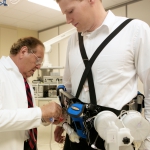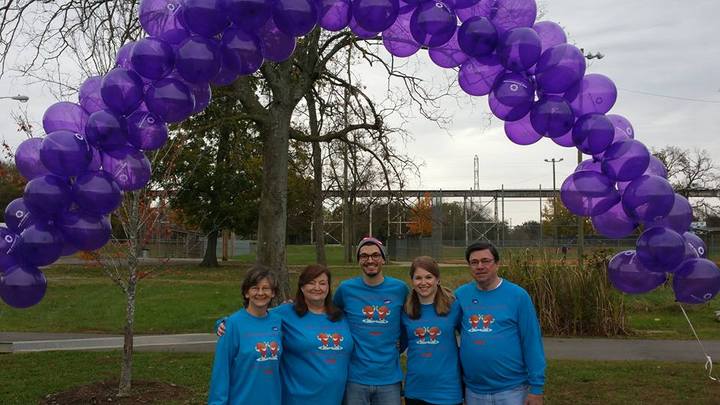From Tech Times, by Katherine Derla

In the United States, approximately 26 million people are affected by kidney disease with an estimated 5 percent annual increase in end-stage renal disease (ESRD) or kidney failure. Patients with ESRD rely on routine dialysis treatment which can extend their lives but leaves patients with very poor quality of life.
The Kidney Project, a collaboration between the Vanderbilt University and the University of California aims to revolutionize ESRD treatment. Led by Dr. William H. Fissell and Dr. Shuvo Roy, a team of researchers developed a new implantable bioartificial kidney that improves the health and financial implications of ESRD, particularly among patients who rely on dialysis treatments that can accumulate an annual cost of up to $89,000.
The implantable artificial kidney, which is about the size of an average coffee cup, imitates the capabilities of a normal, healthy kidney. To address the increasing deaths among waitlisted transplant patients, The Kidney Project's bioartificial kidney offers patients with less expensive and non-invasive continuous ESRD treatments that enable them to be more mobile.
"We aim to conduct clinical trials on an implantable, engineered organ in this decade, and we are coordinating our efforts with both the National Institutes of Health (NIH) and the U.S. Food and Drug Administration," said Roy.
The device will be implanted beside the patient's own kidneys, which will not be removed, and will be connected to the patient's bladder and blood supply. The team employed methods involved in the production of microelectromechanical systems and semiconductor electronics to create the bioartificial kidney, which works using blood pressure and without the aid of electronic power of pump. The bioartificial kidney has a silicon nanofilter that mimics a normal kidney by removing water, small molecules, toxins and salt from the blood.
The Kidney Project is currently in its second stage of development. Phase Two involves extensive refinement of the bioartificial kidney, device test, development of pre-clinical testing prototypes and human clinical tests which involves ESRD patients. Set to conclude in 2017, the project's timeline depends on funding. While the team works with funds from federal grants, The Kidney Project is still in need of $8 million to complete Phase Two.
The Kidney Project has already reached out to donors and investors. It has also created online crowdsourcing campaigns to help raise the needed budget, which has been supported by the ESRD patient groups.
From Mass Device, by FINK DENSFORD

The FDA granted expedited access pathway status for a Wearable Artificial Kidney being developed at the University of Washington’s Medical Center in Seattle, the school reported earlier this month.
The Wearable Artificial Kidney is a battery-powered hemodialysis machine composed of miniaturized components worn as a tool belt and connected to the patient via catheter, UW Medical said.
The approval came based off the successful results of a 7-patient clinical trial of the device carried out at the UW Medical Center between October 2014 and April 2015, despite technical issues that halted the trial early on, the group said.
“Treatment with the WAK was safe, well-tolerated and effectively cleared patients’ uremic toxins while maintaining electrolyte and fluid balance. These results serve as proof-of-concept that, after the device is redesigned to overcome technical problems, a wearable artificial kidney can be developed as a viable dialysis technology,” Kidney Research Institute director Dr. Jonathan Himmelfarb said in prepared remarks.
Patients wore the device for a 24-hour period, Himmelfarb said. Investigators in the trial said patients equipped with the device “expressed excitement to walk around hospital hallways” while the device was functioning, and that the device functioned “admirably.”
“When patients perform hemodialysis at home, only a few options exist and they are large, heavy and stationary. The WAK represents the first truly portable hemodialysis machine, which could enhance patients’ quality of life and enable them to work and travel as they would otherwise,” study investigator Dr. Matthew Rivara said in a press release.
Because the WAK continuously filters blood, subjects were also temporarily freed from food restrictions associated with salt, potassium and phosphorous, which accumulate in patients undergoing chronic dialysis.
“I was amazed at how well it worked for me. It was heavy and cumbersome, but I’d be wearing it today if I could. It just gives you so much more freedom,” test subject Chuck Lee, who has had diabetes for 40 years and received thrice-weekly dialysis for over 2 years, said in a prepared statement.
Despite eating foods that would normally be restricted, the device reported metabolic and other fluid counts in a healthy range, according to Lee’s wife.
Expedited access pathways grants the group more immediate review from the FDA as they submit material to the agency.
“If we can complete the design expeditiously, they’ll look at it very fast, and even during redesign, they’ll give guidance so we’re not making decisions that compromise our chances to get to the next stage. The WAK showed it could dialyze patients for the full 24 hours, with pretty good results, and that’s a big proof of concept. We have a lot of work to do, but this technology has potential to change quality of life in a big way,” trial co-lead Dr. Larry Kessler said in a press release.
PKD Fundraising
From Express & Star, United Kingdom
WATCH: Burntwood marathon runner hopes donations will 'tumble' in

A marathon runner from Burntwood has found a unique way to up the ante - by strapping a four stone tumble dryer to his back.
That is the length Phil 'the tumble dryer' Box goes to to raise money for his nephew and step-brother who suffer from life debilitating condition Polycystic Kidney Disease (PKD).
The 29-year-old from Oakdene Road said he started running a few years ago simply to 'clear his head' but having realised he had a natural talent for it he soon ran out of ways to make it more challenging.
He said: "I started running if I had an argument at home or something and it just progressed from there.
"I joined a running club, then ran a marathon, then started doing the ultra marathons which are 100 miles, then I thought what 'am I going to do now?'
"Eventually it just came to me 'I'll try it with a tumble dryer on my back', I was in the kitchen and it was just staring me in the face."
Remarkably, the carpenter and joiner was told to 'calm down' by doctors in December after he was admitted to hospital with chest pains and a suspected heart attack.
But undeterred, Mr Box was out a week later scampering around Chasewater.
And when he came up with the idea to stick a tumble dryer to his back - partly inspired by another runner called Tony the Fridge - he did not exactly ease himself in.
Instead he took on three marathons in three days managing to carry it for around half of the distance.
"It's quite awkward. From the start you are in quite a bit of pain which you carry with you all the way until the end," he said.
But it is worth it to raise money for the PKD charity which he has already generated more than £1,000 for through various running events.
His step brother Craig |Turner and nephew four-year-old Charlie Turner both have the disease which causes a range of health problems and can eventually lead to kidney failure.
Mr Box said: "PKD is treatable and they can pre-long it but at the moment there isn't a cure.
"That's why I am doing this. If people like me don't raise awareness for PKD then there will never be a cure."
Mr Box's next running challenge is on Sunday, when he will be running on a treadmill - without the tumble dryer this time - at Burntwood Leisure Centre for the venue's entire opening time, some 14 hours 30 minutes.
To sponsor Mr Box text 'Tumb85' followed by the donation amount to 70070.
From Michigan City - La Porte Indiana... Mark Your Calendar

Sunday, May 15, 2016
12:00PM - 2:30PM
Cruis'n For a Cure for PKD Car show and Car cruise.
Car Show and 40-mile car cruise, $10 per vehicle, all wheels welcome. Rain or Shine. Concessions, trophies, prizes, LaPorte County Fairgrounds
Tracking PKD Progression
From Business Wire
The Critical Path Institute (C-Path) announced today that the European Medicines Agency (EMA) rendered a positive qualification opinion to C-Path’s Polycystic Kidney Disease Outcomes Consortium (PKDOC) for total kidney volume (TKV) as a prognostic biomarker to select patients for clinical trials of new therapies for Autosomal Dominant Polycystic Kidney Disease (ADPKD).
ADPKD affects approximately 12 million people worldwide. There is only one medication developed to treat ADPKD, called tolvaptan, which has not yet been approved in the U.S.
TKV is a measurement of the impact of ADPKD on kidney size and is considered to be predictive of decline in kidney function. The EMA opinion states, “CHMP supports baseline total kidney volume, in combination with patient age and eGFR as a prognostic biomarker to identify patients likely to experience a progressive decline in renal function, as characterized by a decline in eGFR or progression to end-stage renal disease.
“From the data provided it is reasonable to expect that baseline TKV can predict disease progression and is a biomarker valuable for risk stratification."
”This qualification, along with a similar one from FDA, confirms the relationship between TKV and ADPKD disease progression, and will help in the design of clinical trials for new therapies for ADPKD” says C-Path COO and PKDOC Co-Director Steve Broadbent.
The PKDOC created a Clinical Data Interchange Standards Consortium (CDISC) data standard for ADPKD and used it to remap data from patient registries and observational studies. The database was used to develop a joint model linking baseline TKV with clinical outcomes.
About the organizations:
C-Path, a nonprofit, was established in 2005 to deliver on FDA’s Critical Path Initiative. C-Path has established 12 global, public-private partnerships that include regulatory agencies, academia, patient advocacy organizations, and pharmaceutical companies. C-Path has headquarters in Tucson, AZ, and has been funded by public and private support. For information, visit www.c-path.org.
The PKD Foundation is the only US organization solely dedicated to finding treatments and a cure for PKD, through promoting programs of research, education, advocacy, support, and awareness on a national level, along with services in local communities. Visit pkdcure.org to learn more.



